< Back
Intensifier Control
Modulated Intensifiers for Lifetime Imaging
As part of its portfolio, Lambert Instruments designs and manufactures ICCD cameras based on modulated image intensifiers for frequency domain imaging techniques such as FLIM. Standard products such as the new TRiCAM M ICCD camera, the TRiCATT M modulated intensifier attachment, and the LIFA system are all based on a proximity-focused modulated Gen II or Gen III image intensifier.
The modulated sensitivity of an image intensifier is produced by high-frequency switching of its photocathode voltage. In this modulation mode the temporal and also the spatial characteristics of the image intensifier are different from the nominal characteristics under continuous operation.
The following table lists the nominal characteristics for the Gen II and Gen III intensifiers provided.
GEN II S20 & S25
GEN III GAAS
GEN III GAASP
Spatial resolution
Photocathode QE at 550 nm
28 lp/mm
14%
17 lp/mm
28%
7 lp/mm
48%
The increased sensitivity of the Gen III image intensifier results in a better lifetime accuracy, although the amount further depends on the model and the modulated light source used. For a LIFA Gen III GaAs compared to a LIFA Gen II S25 at 550nm, both using the same Multi-LED light source, the increased sensitivity results in an increased lifetime accuracy of 40% at the same acquisition speed and fluorescence intensity.
For phosphorescence lifetime imaging with the TRiCAM GM and the LIFA-P the image intensifier is operated at lower frequencies spatial resolution is higher, reaching values in excess of 35 lp/mm for a Gen III GaAs image intensifier.
Please note that the characteristics of an image intensifier are unique and are known to vary between units.
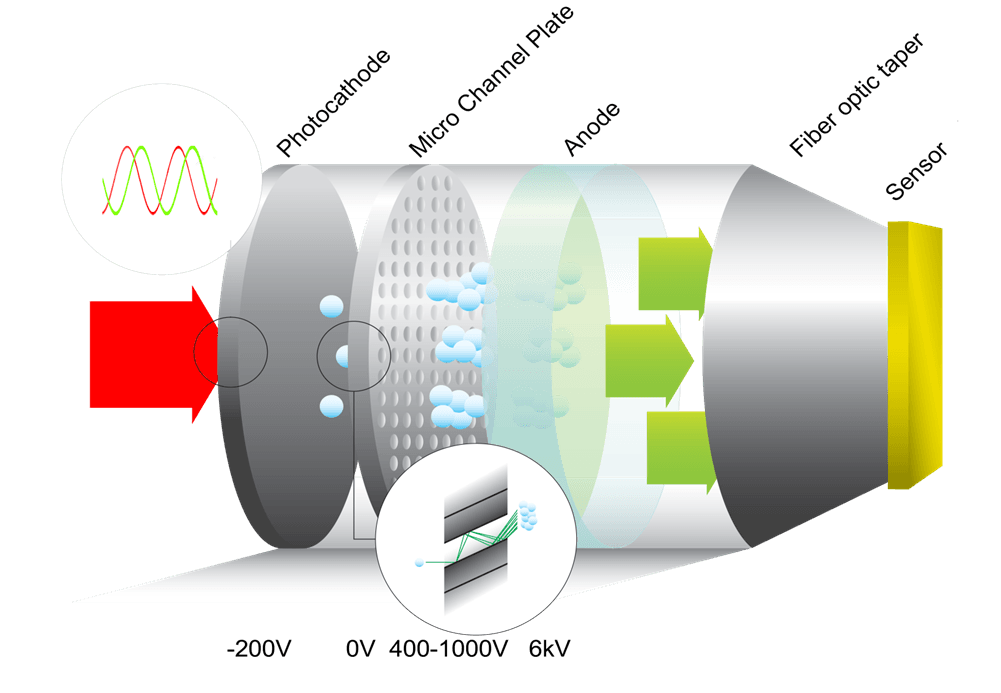
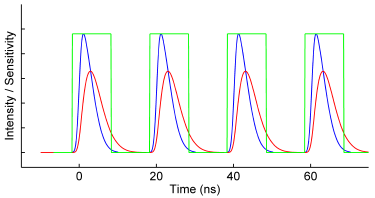
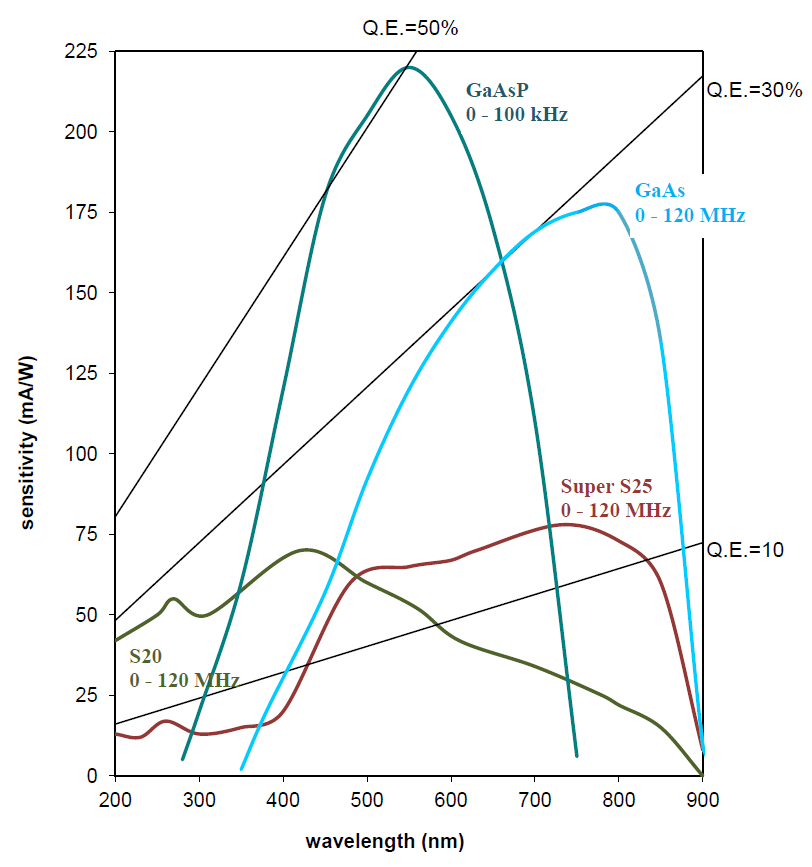
Dual-Stage Image Intensifier
The limiting spatial resolution of an intensified imaging system depends on several factors, including (but not limited to)
-Image intensifier type
-Image intensifier gain
-Pixel size
Before we can discuss each of these factors, we need to define what limiting spatial resolution means. When characterizing an imaging system, the limiting spatial resolution describes the smallest features that can be distinguished. There are several ways of characterizing the spatial resolotion, most of them use a test chart like the USAF resolution test chart. Such charts have a series of lines on them, the smaller the lines an imaging system can distinguish, the better the spatial resolution.
Spatial resolution is quantified in the number of line pairs that can be distinguised per millimeter (lp/mm). A line pair consists of a dark line and a bright line. So if one line is 5 microns wide, then a line pair will be 10 microns wide and there would be 1 mm/10 microns = 100 line pairs per millimeter.
IMAGE INTENSIFIER TYPE
There is a wide range of image intensifiers available. We advise our customers on the type of intensifier they need for their application based on the wavelengths that are important for our customers, and the frame rates they need. High-speed intensifiers usually have a lower spatial resolution than image intensifiers that are optimized for lower frame rates.
IMAGE INTENSIFIER GAIN
We can increase the MCP voltage of an image intensifier to increase its gain. But MCP noise and the size of the electron cloud at the exit of the MCP also depend on the MCP voltage, so the spatial resolution will be slightly reduced as the MCP voltage is increased. You can learn more about how an image intensifier works on our image intensifier page.
PIXEL SIZE
Finally, the limiting spatial resolution of an imaging system is determined by the size of the pixels that collect the light from the image intensifier. You can use our intensifier-sensor matching calculator to find the theoretical maximum sensor resolution. It is calculated using the size of the pixels.
For example: If the pixels are 20 microns wide, we would need two adjacent pixels to distinguish a bright line and a dark line of a test chart. Those two pixels would have a total width of 40 microns, so the theoretical spatial resolution would be 1 mm/40 microns = 25 lp/mm.
The element of the imaging system with the lowest spatial resolution determines the limiting spatial resolution of the whole system. In our example, we have a sensor that has a limiting resolution of 25 lp/mm. If we have an image intensifier with a 50 lp/mm resolution, the size of the pixels would limit the resolution of the imaging system to 25 lp/mm.
However, if the pixels are smaller, 2 microns for instance, then the theoretical resolution of the sensor would be 250 lp/mm. In that case, the resolution of the image intensifier would determine the resolution of the total system.
OTHER FACTORS
Many factors influence the spatial resolution of an intensified imaging system, like the size of the image intensifier, the number of image intensifiers and the optics. If you would like more information about the right image intensifier for your application, please contact us.
Intensified Cameras and Attachments
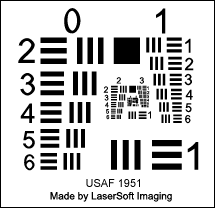
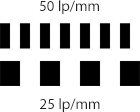

HiCATT
The High-speed Intensified Camera Attachment (HiCATT) is designed for use with a high-speed camera. It increases the sensitivity of your camera and enables low-light imaging at frame rates up to 1 MHz (10 Mhz in burst)
View Product
HiCAM
The HiCAM is a gated intensified high-speed camera. It has an integrated fiber-optically coupled image intensifier, which offers a unique combination of high speed and sensitivity down to single photon level. Because the HiCAM does not need high intensity light sources, it is suitable for use in low-light level conditions.
View Product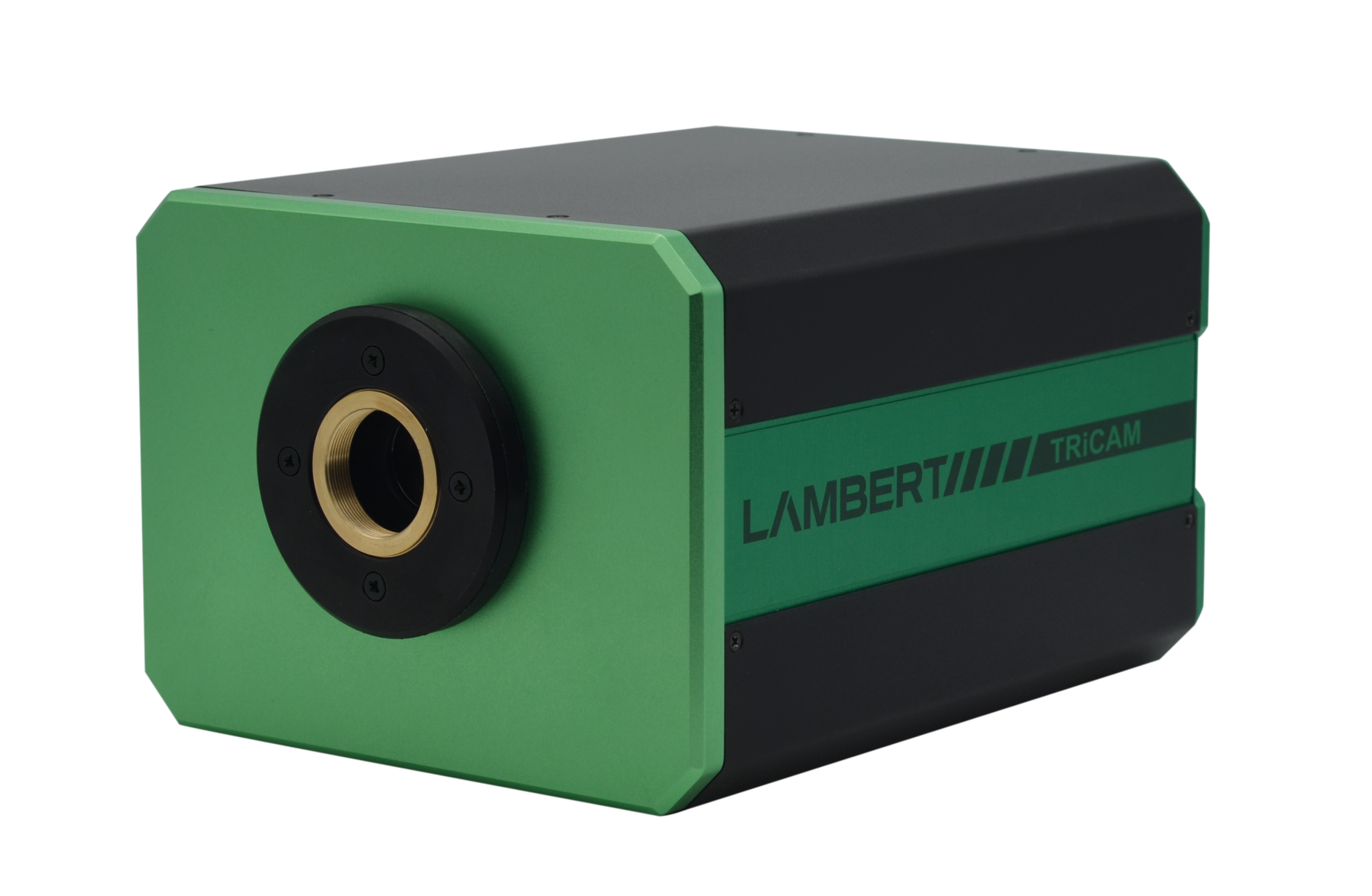
TRiCAM
The TRiCAM is a compact intensified camera. It is designed for scientific and industrial applications that require low-light imaging. With built-in signal generators, the TRiCAM is capable of ultra-short exposures through fast gating and therefore suitable for time-resolved imaging.
View Product
TRiCATT
The TRiCATT is a compact lens-coupled image intensifier for scientific and industrial applications that require: – Low-light level imaging – Ultra-short exposures through fast gating – Frequency-domain imaging using lock-in detection Any camera with C-mount and a 1/2″, 2/3″, or 1″ image sensor is compatible with the TRiCATT. You can find the right TRiCATT for your camera with our interactive calculator.
View ProductDual-Stage Image Intensifier
In very low-light situations or when a very short exposure time is required, a dual-stage image intensifier may be required. The first stage is the same as a single-stage image intensifier; it has a micro-channel plate that multiplies the electrons emitted by the photocathode. The second stage is often referred to as a booster. This stage does not have a micro-channel plate, it multiplies the incoming photons without the saturation characteristics of a micro-channel plate.
DUAL-STAGE IMAGE INTENSIFIER WITH FIBER-OPTIC COUPLING
For FLIM in the lifetime range of 0 ps to 1 ms we provide S20 (UV) and SuperS25 (visual) image intensifiers. For increased quantum efficiency of the photocathode in the visual part of the spectrum in this lifetime range, a GaAs intensifier is available. For near-infrared applications up to about 1100 nm an InGaAs photocathode is available.
The graph to the right shows the spectral sensitivity of these photocathodes.
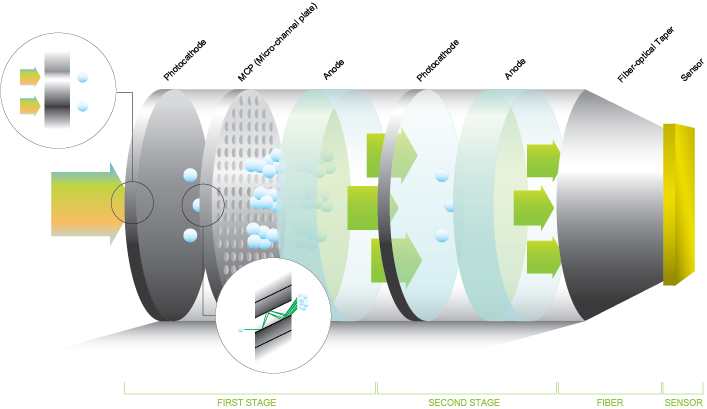
Intensified Cameras for Lifetime Imaging
Intensified cameras enable full-field frequency-domain and time-domain FLIM. The image intensifier becomes an ultra-fast electro-optical shutter by operating it at radio frequencies allowing time-resolved imaging. The high-resolution image intensifier is the key component of the TRiCAM (part of the LIFA) and the TRiCATT camera attachment. Its photon gain is typically in the range of 100 to 10000. Lambert Instruments provides different image intensifiers based on photocathodes with different spectral sensitivity to match a range of applications in the UV, visible and NIR.
For FLIM in the lifetime range of 0 ps to 1 ms we provide S20 (UV) and SuperS25 (visual) image intensifiers. For increased quantum efficiency of the photocathode in the visual part of the spectrum in this lifetime range, a GaAs intensifier is available. For near-infrared applications up to about 1100 nm an InGaAs photocathode is available.
The graph to the right shows the spectral sensitivity of these photocathodes.
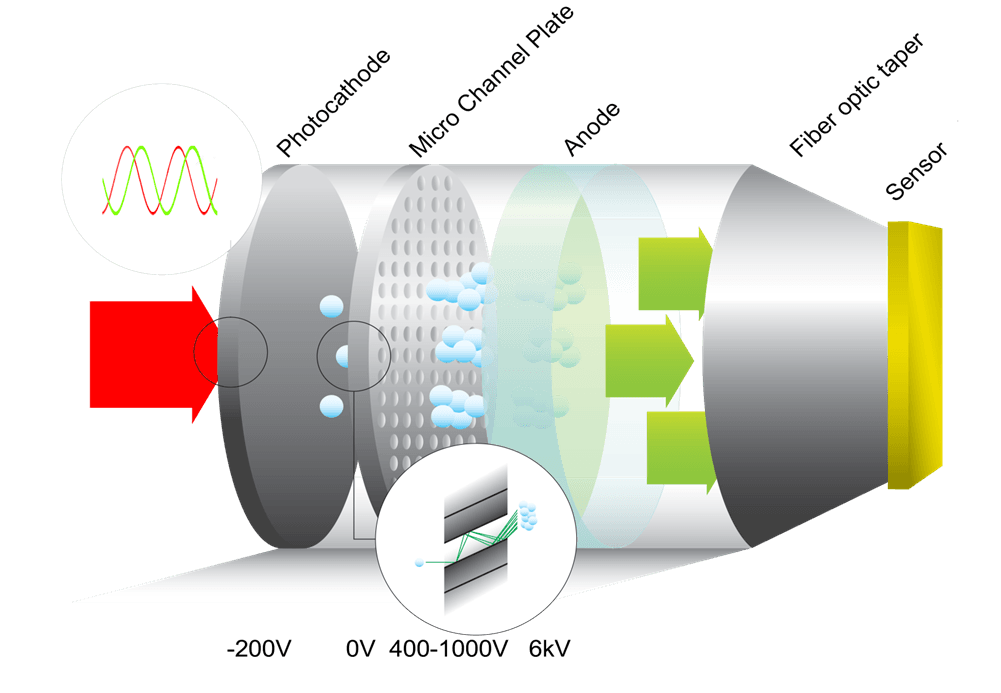
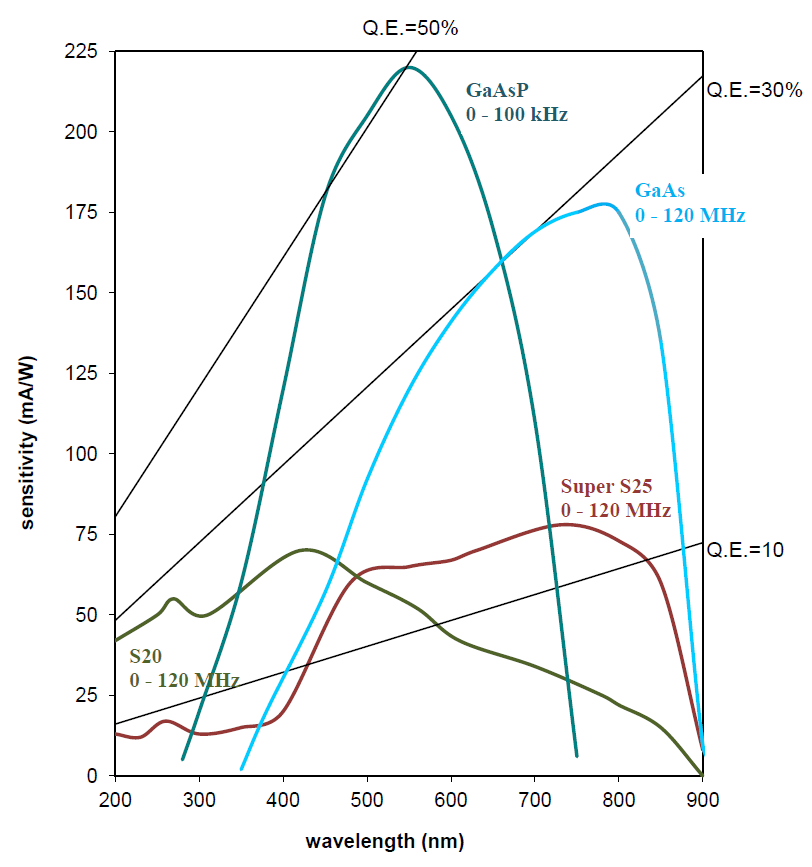
The Image Intensifier
An image intensifier is a device that intensifies low light-level images to light levels that can be seen with the human eye or can be detected by a camera. An image intensifier consists of a vacuum tube with several conversion and multiplication screens.
An incident photon will hit a light sensitive photo-cathode screen. Photons are absorbed in the photocathode and give rise to emission of electrons into the vacuum. These electrons are accelerated by an electric field to increase their energy and focus them on the multi channel plate (MCP).
Inside the MCP the electron image is multiplied, after which the electrons are accelerated towards an anode screen. The anode screen contains a layer of phosphorescent material that is covered by a thin aluminium film.
The anode contains a phosphor such that when striking the anode the energy of the electrons is converted into photons again. Because of the multiplication and increased energy of the electrons the output brightness is higher as compared to the original input light intensity.
Intensified Cameras and Attachments
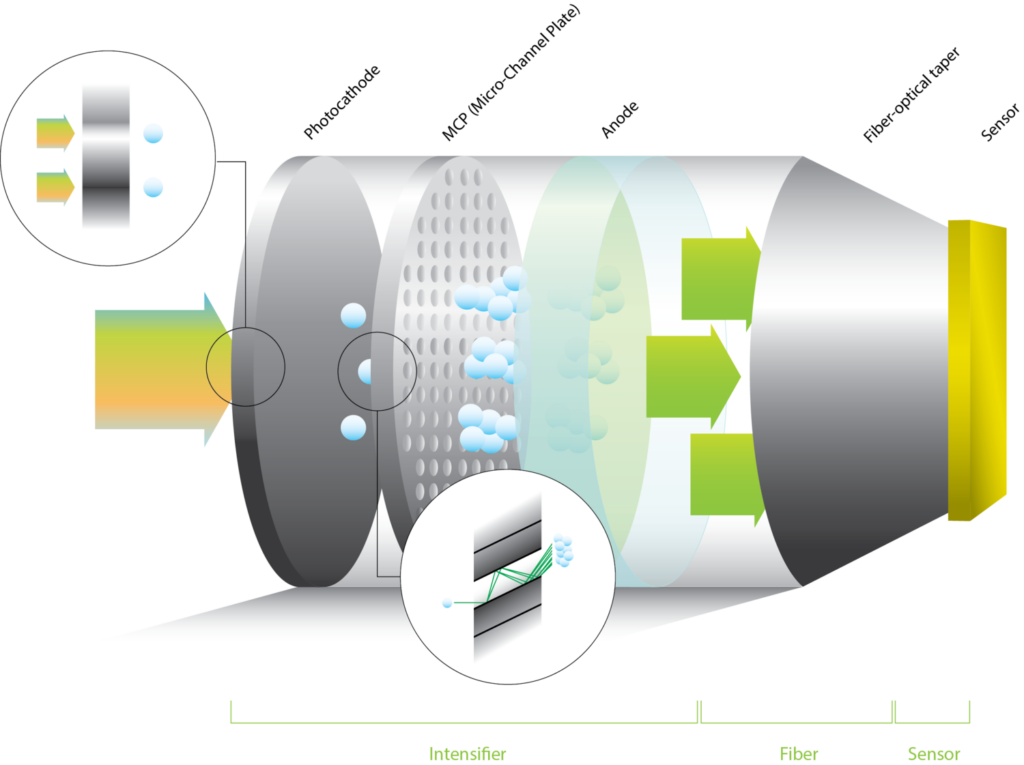

HiCATT
The High-speed Intensified Camera Attachment (HiCATT) is designed for use with a high-speed camera. It increases the sensitivity of your camera and enables low-light imaging at frame rates up to 1 MHz (10 Mhz in burst)
View Product
HiCAM
The HiCAM is a gated intensified high-speed camera. It has an integrated fiber-optically coupled image intensifier, which offers a unique combination of high speed and sensitivity down to single photon level. Because the HiCAM does not need high intensity light sources, it is suitable for use in low-light level conditions.
View Product
TRiCAM
The TRiCAM is a compact intensified camera. It is designed for scientific and industrial applications that require low-light imaging. With built-in signal generators, the TRiCAM is capable of ultra-short exposures through fast gating and therefore suitable for time-resolved imaging.
View Product
TRiCATT
The TRiCATT is a compact lens-coupled image intensifier for scientific and industrial applications that require: – Low-light level imaging – Ultra-short exposures through fast gating – Frequency-domain imaging using lock-in detection Any camera with C-mount and a 1/2″, 2/3″, or 1″ image sensor is compatible with the TRiCATT. You can find the right TRiCATT for your camera with our interactive calculator.
View ProductFirst Generation Image Intensifier
A first generation image intensifier does not use a micro-channel plate. The electrons are guided from the input to the output by means of electrostatic focussing. Two types can be distinguished: proximity focussed diodes and electrostatic inverters. In the latter a structure of electrodes form an electrostatic lens that focusses the electrons coming from cathode onto the anode. The advantage of electrostatic focussing is that it allows de-magnification of the image. This is especially interesting when these devices are coupled to small CCDs.
Advantages of first generation tubes
Available in de-magnifying formats
Therefore no fiber optic taper required
No MCP noise
High intra-scene dynamic range
Low cost (standard models)
Disadvantages
Electrostatic inverters show a few percent of image distortion
Relatively low gain
Gating not possible
No UV sensitivity
Limited external gain control
Poor over-illumination protection
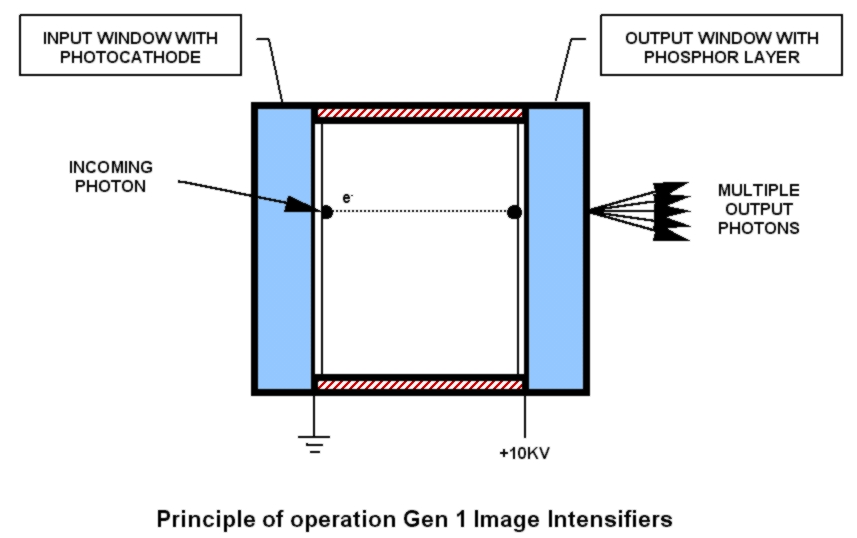
Second Generation Image Intensifier
In the second-generation image intensifier a so-called Micro-Channel Plate or MCP is added, improving the gain of the image intensifier enormously. The MCP is placed between the cathode and the anode and acts as an electron multiplier.
The MCP is a 0.5 mm thick plate with millions of 6 micron wide holes. An accelerated electron coming from photocathode will be accelerated towards the MCP. When the electron hits the wall of one of the MCP channels it will spawn secondary electrons. Due to the voltage over the MCP, these electrons will also be accelerated, and hit the surface of the MCP in their turn. Again spawning new (tertiary) electrons. This process is repeated several times, resulting in an electron gain far higher (several thousand times higher) than in first generation intensifiers.
When an electron leaves the MCP, it is propelled to the phosphor screen where it will generate multiple photons. The overall gain of an image intensifier is up to ten thousand. With two or three MCPs amplifications up to 10 million times gain is possible. The gain of the image intensifier can even be controlled by changing the voltage over the MCP.
GATING THE IMAGE INTENSIFIER
An important feature of the MCP, and therefore the second-generation image intensifier, is that it can be gated. Gating the image intensifier offers a whole new possibility of using the image intensifier as an ultra fast (electro-optical) shutter. Gating is achieved by controlling the photocathode voltage of the image intensifier, creating a shutter with effective exposure times down to a few nanoseconds.
By applying a negative voltage to the photocathode, typically -200 V with respect to the MCP input, photoelectrons are generated in the photocathode. They are emitted and accelerated to the MCP to be multiplicated. In this situation the image intensifier is “gated on”. When applying a small positive voltage to the photocathode, typically 50 V with respect to the MCP, the photoelectrons can not be emitted and the intensifier is “gated off”. With this gating option the input light range is extended significantly and it offers unique options for time resolved experiments.
In the Lambert Instruments Fluorescence Attachment, a second-generation image intensifier is used as a detector. The image intensifier, combined with a CCD camera, is attached to a widefield fluorescence microscope. The photocathode of the intensifier is located in the image (focal) plane of the microscope. In the frequency domain LIFA, the photocathode is switched from positive to negative at the same frequency as the light source is modulated.
Furthermore gating can be used to reduce or prevent the effect of motion blur when capturing fast moving objects. In our Intensified cameras gating is standard synchronised with the exposure period of the CCD or CMOS sensor.
ADVANTAGES
Fibre-optic/glass/quartz/MgF2 input windows
Many photocathode types from UV to NIR
High gain
Fast shuttering is possible (gating)
Good over-illumination protection
Maximum output brightness control
Wide gain control range
Many types of output phosphors
Distortion free
DISADVANTAGES
Limited intra-scene dynamic ranges
Low maximum output brightness for fast phosphors
No de-magnifying models
MCP introduces extra noise
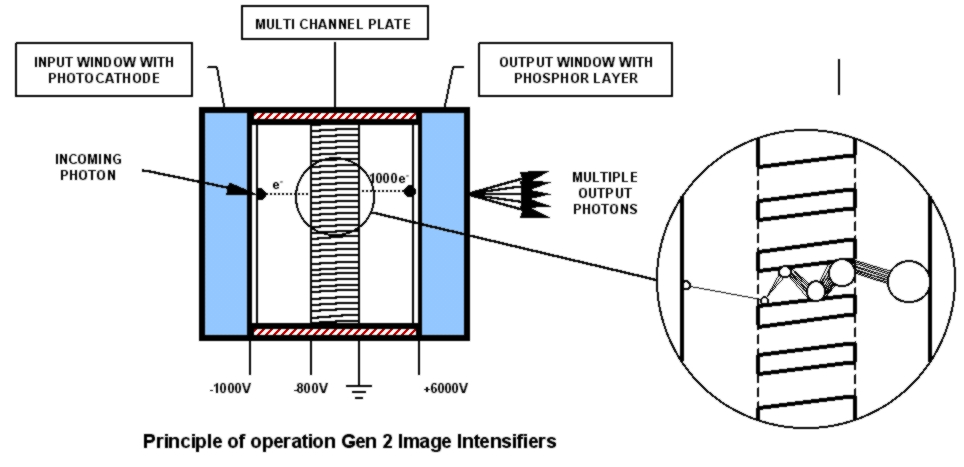
Third Generation Image Intensifier
The next step in technology is the third generation (GenIII) image intensifier in which the multi-alkali photocathode is replaced by a Gallium-Arsenide (GaAs) or a Gallium-Arsenide-Phosphide (GaAsP) photo-cathode. The quantum efficiency (QE) of these types of photo-cathodes are much higher as compared to the multi-alkali photocathode of the second-generation image intensifiers.
Recently, new filmless Gen III intensifiers have been developed that are using the high QE to its full extend. The higher QE results in a better SNR or in shorter exposure times at equal SNR. In the graph, spectral sensitivity curves of multialkali photocathodes, such as S25, S20 and broadband, are shown in comparison with GaAs and GaAsP photocathodes.
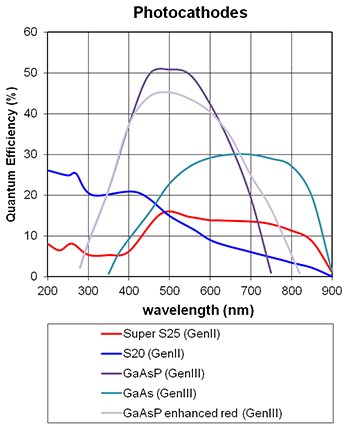
Fiber-Optic Coupling
It is important that image quality is maintained as much as possible when using intensifiers. At the same time, light efficiency should be maximized. This can be achieved by using a fiber-optic window as the output of the first stage and as the input of the second stage.
An image intensifier can also serve as a radiation converter. Images in the part of the spectrum that are invisible to the human eye (for example UV or NIR) can be converted to a different part of the spectrum that can be detected by an image sensor. The spectral sensitivity of the image intensifier is determined by the type of photocathode that is chosen.
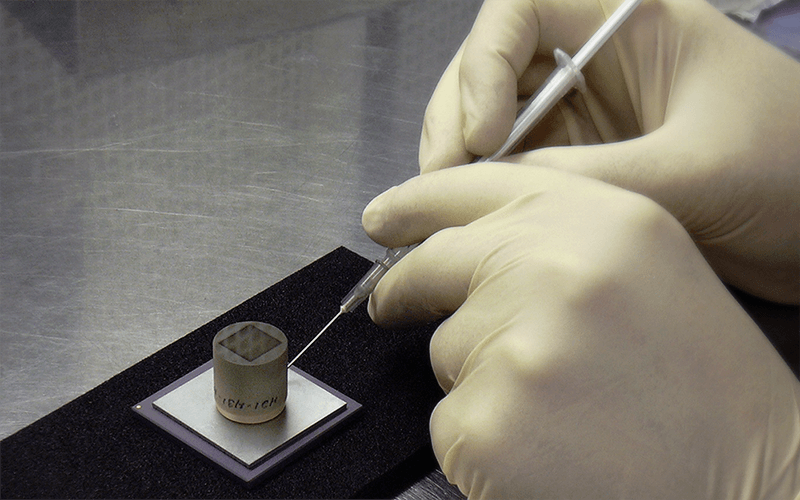
Intensifier Gating for Ultra-Short Exposure Times
Apart from the obvious advantages of gain and intensification, the intensifier offers additional possibilities. It can serve as a fast shutter, by use of gating. At a negative cathode voltage, the intensifier is open. It closes at a positive voltage. Switching can be done very quickly and at high repetition rates, resulting in very short exposures (down to nanoseconds), synchronized with a camera that can operate at very high frame rates. Ultrashort exposure will reduce any motion smear to a minimum. The figure below shows a recording sequence of a combustion cycle of a fuel injection engine at 22000 fps, made with a gated intensified high-speed camera.

An image intensifier can also serve as a radiation converter. Images in the part of the spectrum that are invisible to the human eye (for example UV or NIR) can be converted to a different part of the spectrum that can be detected by an image sensor. The spectral sensitivity of the image intensifier is determined by the type of photocathode that is chosen.


